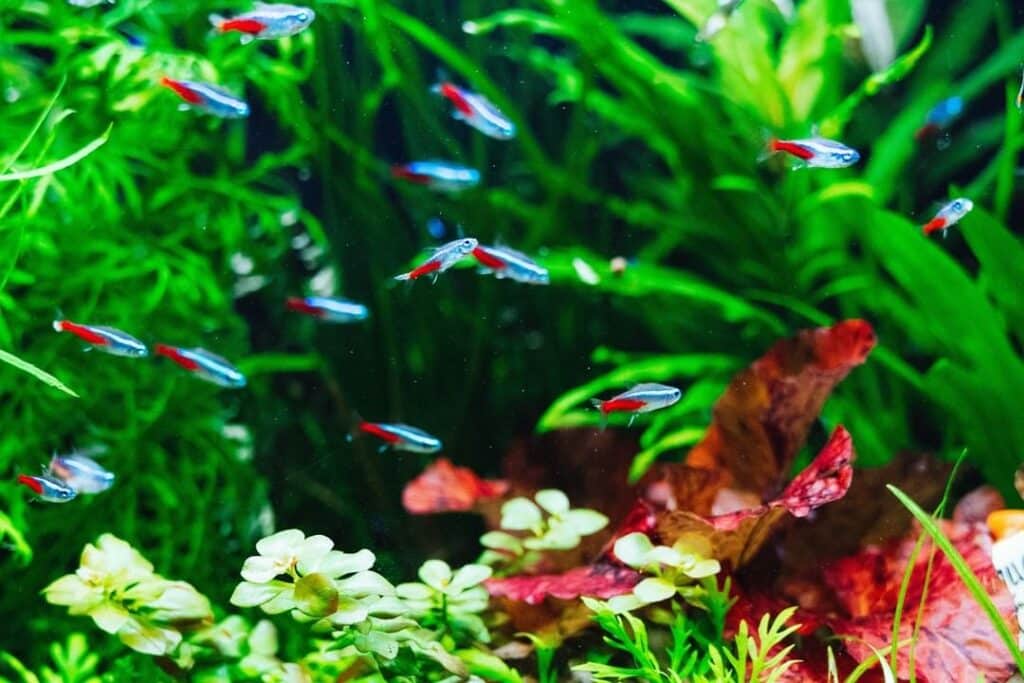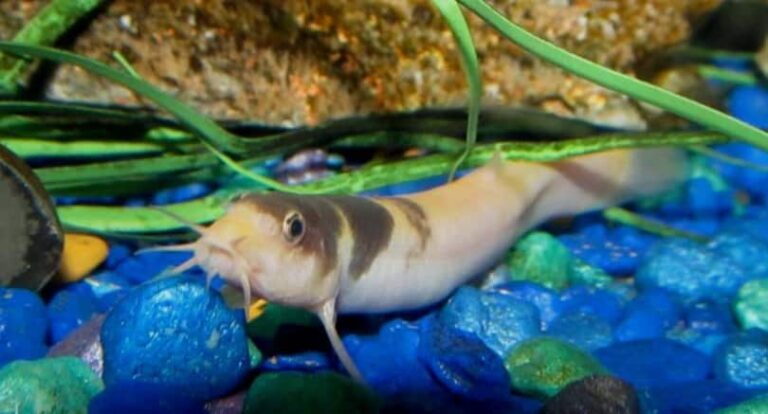Neon Tetra
The Paracheirodon Innesi, commonly known as Neon Tetra, belongs to the Characiformes order and Characin family. It is a fish from the freshwater category and is endemic to the clear water or Blackwater streams situated in Southeastern Colombia, Brazil, and eastern parts of Peru. This species is also found in some tributaries, where the water temperature is about 20 to 26 degrees C. They display an array of attractive and bright colors, which is the reason for their popularity among fish hobbyists.

Description
The Neon tetra attains a body length of about 3 cm. Sexual dimorphism is very less; the female fish have a slightly bulgier stomach than its male counterpart. This fish has a white colored stomach and a light blue shining back. It is nearly transparent except for the strips running over its body. The body displays strips of iridescent red and blue colors running from the middle of the body to the base of the caudal fin and from the nose to the adipose fin on both the sides respectively. A green shining line is rarely found in this species. These fish have a life expectancy of more than 10 years, but usually they live up to 5 to 8 years in captivity.
Breeding
The other difference in the male and female fish is that the males are a bit slender and have a straight blue line, whereas the females have a bit bent line and a stout body. During the reproduction process, the male and the female counterpart should be placed in a breeding tank with no lights, then you can increase the lights gradually till the reproduction takes place. Changing of 50% of water also induces them, as in their natural habitat; they get stimulated from the fresh rain. The other inducing conditions are the hardness of the water, which should be less than 4dGH and the mosquito larvae. These creatures spawn in every two weeks and lay eggs on the plant leaves or other substrates. The male fish fertilizes the eggs and it takes around 24 hours to hatch. The fry takes about 1 month to attain the parent’s attractive color and other features.
Diseases
The Neon Tetra fish is often affected by a deadly disease termed as “neon tetra disease” or NTD. Technically, it is called as Pleistophora, and it is affected by Pleistophora Hyphessobryconis. This Sporozon disease is incurable and very fatal to the Neon Tetra Fish. It is caused due to the consumption of infected or decayed food like the remains of dead fish or any live food like Tubifex. It causes restlessness, difficulty in swimming, lumps on the body, color loss, bloating and fin rot, and as the disease advances, the spine gets curved and eventually, the fish dies. Till date, no medicine has been developed to overcome this disease. The only thing to control this disease from spreading is to keep away the infected fish out of the tank. Installing a Diatom Filter that helps to keep away the free parasite growing in the water can be helpful.
Food
These fish are basically omnivores, which mean they eat both the plants and animals. They mainly eat algae, insect larvae and small invertebrates in their natural habitat. While breeding in aquariums, you can provide any kind of fine or grounded food. To provide all the nutrients, give them a premium quality flake diet. You can also include brine shrimp either fresh or frozen and blood worm occasionally. They should be strictly provided less amount of food that lasts maximum for 3 minutes, but you give it to them several times. Frozen foods like black worms and fruit flies are also preferred by these fish.
Water
The Neon Tetra prefers soft and clean water to stay healthy. They prefer a pH level of about 6 but can also adjust between 5 and 7. The water hardness should be negligible or immeasurable, and the temperature preferred is between 68 and 74 degree F. The water should be clear and clean, hence regularly change the water for the healthy growth of these fish.
Tank
These small sized fish require a tank of 10 gallons. As they have originated from the South American region, they prefer a lot of plants around them. Hence, you can place many hardy plants inside the tank. There should also be enough places to hide; hence you can place small and big rocks. For mimicking their habitat, you can simply place some dimming lights, floating plants or other decorations. They don’t prefer to stay alone in the tank. They are very peaceful creatures; hence you can add some tank mates for these Neon tetras. The suitable tank mates are-:
- Cherry Barb
- Cardinals
- Cherry Barb
- African Dwarf Frogs
- Rummynose
- Other Tetras
How to Properly Install the Fish Tank for Your New Neon Tetras

Neon Tetras are very easy to breed and best suited for beginners, although, you have to provide some specific requirements in the tank to make them feel comfortable, similar to their natural habitat. The things you will need to set up the tank are-:
- 10 0r 20 gallon tank
- Live and plastic plants
- Aquarium gravel or any dark substrate
- Aquarium test kit
- External Heaters
- Filter
Now we can start with setting up the tank for neon tetras.
- Wash thoroughly the aquarium gravel, ornaments and rocks. Avoid using soap or harsh detergents as they can be poisonous to these fish. You can wash the gravel by placing it in a colander on a plastic bucket or pan, and then, by adding water. Stir the gravel and drain the water. When all the debris is cleared and the water used to clean stays clear it means the gravel is free from dirt.
- Fill the tank about one third full of water. Add a teaspoon of Aqua safe per 10 gallons of water to dechlorinate..
- The tube of the airline should be connected from the air pumping equipment to any available air outlet inside the aquarium.
- Now place the plants, gravel and other decorative items, and add the remaining water till the top.
- Now you can place the exterior filter and fill it with the filter cartridge. The heater should be placed as instructed, and must be kept away from the thermometer. Make sure that the thermometer can be easily read.
- Now you can plug in the heater, air pump and the power filter. Check if everything is working fine, and change their settings if required.
- Now you can check the hardness and pH level of the water with the help of aquarium kit.
- Then, add your fish by floating the cover in which it is brought, in the aquarium water, for about 15 minutes.

Having discovered a fondness for insects while pursuing her degree in Biology, Randi Jones was quite bugged to know that people usually dismissed these little creatures as “creepy-crawlies”.







